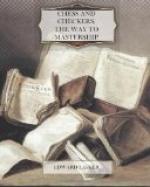Isolated Pawn
A Pawn is called isolated if there are no Pawns of the same player on the adjoining files.
Backward Pawn
A Pawn is called backward if he cannot advance far enough to be protected by fellow Pawns in an adjoining file.
Fork
A Pawn is said to fork two pieces if he attacks them simultaneously.
Minor Piece
The Bishops and the Knights are called minor Pieces as compared with the Rooks and the Queen.
Sacrifice
To sacrifice means to give up a man without obtaining for him a man of the opponent or to give up a man for one of lesser value.
Discovered Check and Double Check
A discovered Check is an attack on the King caused by a man moving out of the line of a piece which he was obstructing. If the man discovering the Check also attacks the King the Check is called a double Check.
SYMBOLS FOR MOVES
In addition to the symbols used for squares and men, as explained on page 5, the following are used to indicate the moves:
— means “moves to”
X means “captures”
o-o means “Castles King’s side”
o-o-o means “Castles Queen’s side”
+ means “check”
+/- means “checkmate”
Thus: R-f5 means the Rook moves to square f5. If either Rook could move to f5 then the original square of the Rook to be moved must also be shown.
Kte3xd5 means the Knight standing on e3 captures the man standing on d5.
o-o-o means the player castles Queen’s side and in so doing gives check.
[Footnote: In the descriptive notation alluded to on page 5 every square of the board has two different names, each player counting the ranks from his own side. The files are named after the pieces which stand on them at the beginning of the game. Thus, c4 would be QB4 (Queen’s Bishop’s fourth) or QB5 depending on whether a black or a white move is described. If a square is referred to without relation to a particular move it is necessary to add from which side of the board the square is counted. It is customary to say in cases of this kind “White’s Queen’s fourth” or “Black’s Queen’s fourth,” etc.
Instead of naming the square on which a capture takes place, the man captured is named, so that an additional description is necessary in case more than one man of the same kind can be captured.
As a matter of comparison the first ten moves of a game are described above in both notations.]
! signifies a good move.
? signifies a bad move.




